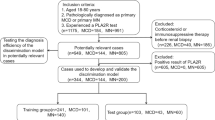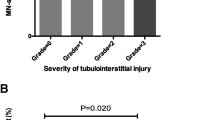Abstract
Background
Phospholipase A2 receptor (PLA2R)-associated membranous nephropathy accounts for the majority of membranous nephropathy; however, few studies have determined the prognostic impact and clinical application of renal pathologic change on this disease.
Methods
A retrospective cohort study of 262 patients with PLA2R-associated membranous nephropathy was conducted. The total renal chronicity score calculated according to the degree of glomerulosclerosis, interstitial fibrosis, tubular atrophy, and arteriosclerosis was applied to evaluate renal chronicity. Baseline bias was adjusted by inverse probability weight when assessing the prognostic impact of chronicity, and multiple parameters were used to evaluate the application value of renal chronicity.
Results
During a median follow-up of 24.5 months, renal outcome (kidney function deterioration and/or end-stage kidney disease) was observed in 22 (8.40%) patients. Not only did a higher total renal chronicity score independently predict renal outcome [odds ratio (OR): 1.562, 95% confidence interval (CI) 1.073–2.273, P = 0.020], but non-minimal chronicity was also an independent risk factor for renal outcome (OR: 3.170, 95% CI 1.040–9.659, P = 0.042). Moreover, the membranous nephropathy risk classification in the Kidney Disease: Improving Global Outcomes (KDIGO) guideline integrated with non-minimal chronicity showed improvements in categorical net reclassification (0.174, 95% CI 0.012–0.335, P = 0.035), continuous net reclassification (0.462, 95% CI 0.087–0.838, P = 0.016), and integrated discrimination (0.019, 95% CI 0.003–0.035, P = 0.020) compared to the original classification.
Conclusions
Renal chronicity is closely associated with renal outcomes in PLA2R-associated membranous nephropathy, and combining the KDIGO risk classification with chronicity scores may provide a more accurate prognostic prediction.
Graphical abstract




Similar content being viewed by others
Data availability
The data that support the findings of this study are available from the corresponding author, [Qi Bian], upon reasonable request.
References
Ronco P, Beck L, Debiec H, Fervenza FC, Hou FF, Jha V et al (2021) Membranous nephropathy. Nat Rev Dis Primers 7(1):69
Alsharhan L, Beck LH Jr (2021) Membranous nephropathy: core curriculum 2021. Am J Kidney Dis 77(3):440–453
Stehle T, Audard V, Ronco P, Debiec H (2015) Phospholipase A2 receptor and sarcoidosis-associated membranous nephropathy. Nephrol Dial Transplant 30(6):1047–1050
Xu X, Wang G, Chen N, Lu T, Nie S, Xu G et al (2016) Long-term exposure to air pollution and increased risk of membranous nephropathy in China. J Am Soc Nephrol 27(12):3739–3746
Berchtold L, Zanetta G, Dahan K, Mihout F, Peltier J, Guerrot D et al (2018) Efficacy and safety of rituximab in Hepatitis B virus-associated PLA2R-positive membranous nephropathy. Kidney Int Rep 3(2):486–491
Couser WG (2017) Primary membranous nephropathy. Clin J Am Soc Nephrol 12(6):983–997
Rovin BH, Adler SG, Barratt J, Bridoux F, Burdge KA, Chan TM et al (2021) Executive summary of the KDIGO 2021 guideline for the management of glomerular diseases. Kidney Int 100(4):753–779
Francis JM, Beck LH Jr, Salant DJ (2016) Membranous nephropathy: a journey from bench to bedside. Am J Kidney Dis 68(1):138–147
Bobart SA, De Vriese AS, Pawar AS, Zand L, Sethi S, Giesen C et al (2019) Noninvasive diagnosis of primary membranous nephropathy using phospholipase A2 receptor antibodies. Kidney Int 95(2):429–438
Poggio ED, McClelland RL, Blank KN, Hansen S, Bansal S, Bomback AS et al (2020) Systematic review and meta-analysis of native kidney biopsy complications. Clin J Am Soc Nephrol 15(11):1595–1602
Bobart SA, Han H, Tehranian S, De Vriese AS, Roman JCL, Sethi S et al (2021) Noninvasive diagnosis of PLA2R-associated membranous nephropathy: a validation study. Clin J Am Soc Nephrol 16(12):1833–1839
Caza TN, Larsen CP (2023) False-positive anti-PLA2R ELISA testing in patients with diabetes mellitus. Kidney Int 103(2):425
Hoxha E, Reinhard L, Castedello T, Becker JU (2023) False positivity for PLA(2)R1 antibody measured by ELISA in a nephrotic patient with no membranous nephropathy. Kidney Int 103(2):411–415
Marx BE, Marx M (1999) Prediction in idiopathic membranous nephropathy. Kidney Int 56(2):666–673
Yoshimoto K, Yokoyama H, Wada T, Furuichi K, Sakai N, Iwata Y et al (2004) Pathologic findings of initial biopsies reflect the outcomes of membranous nephropathy. Kidney Int 65(1):148–153
Ruggenenti P, Chiurchiu C, Abbate M, Perna A, Cravedi P, Bontempelli M et al (2006) Rituximab for idiopathic membranous nephropathy: who can benefit? Clin J Am Soc Nephrol 1(4):738–748
Sethi S, Haas M, Markowitz GS, D’Agati VD, Rennke HG, Jennette JC et al (2016) Mayo clinic/renal pathology society consensus report on pathologic classification, diagnosis, and reporting of GN. J Am Soc Nephrol 27(5):1278–1287
Sethi S, D’Agati VD, Nast CC, Fogo AB, De Vriese AS, Markowitz GS et al (2017) A proposal for standardized grading of chronic changes in native kidney biopsy specimens. Kidney Int 91(4):787–789
Srivastava A, Palsson R, Kaze AD, Chen ME, Palacios P, Sabbisetti V et al (2018) The prognostic value of histopathologic lesions in native kidney biopsy specimens: results from the boston kidney biopsy cohort study. J Am Soc Nephrol 29(8):2213–2224
Caravaca-Fontan F, Lucientes L, Serra N, Cavero T, Rodado R, Ramos N et al (2022) C3 glomerulopathy associated with monoclonal gammopathy: impact of chronic histologic lesions and beneficial effects of clone-targeted therapies. Nephrol Dial Transplant 37(11):2128–2137
Casal Moura M, Fervenza FC, Specks U, Sethi S (2022) Kidney biopsy chronicity grading in antineutrophil cytoplasmic antibody-associated vasculitis. Nephrol Dial Transplant 37(9):1710–1721
Kang D, Ban TH, Chin HJ, Lee H, Oh SW, Park CW et al (2022) Prognostic value of chronicity grading on renal outcomes in patients with IgA nephropathy. Front Med (Lausanne) 9:952050
Deleersnijder D, Knops N, Trouet D, Van Hoeck K, Karamaria S, VandeWalle J et al (2023) Epidemiology and clinicopathological characteristics of native kidney disease in children in Flanders. Belgium Pediatr Nephrol 38(5):1533–1545
Unger T, Borghi C, Charchar F, Khan NA, Poulter NR, Prabhakaran D et al (2020) 2020 International society of hypertension global hypertension practice guidelines. Hypertension 75(6):1334–1357
Hoxha E, Kneissler U, Stege G, Zahner G, Thiele I, Panzer U et al (2012) Enhanced expression of the M-type phospholipase A2 receptor in glomeruli correlates with serum receptor antibodies in primary membranous nephropathy. Kidney Int 82(7):797–804
Dess RT, Hartman HE, Mahal BA, Soni PD, Jackson WC, Cooperberg MR et al (2019) Association of black race with prostate cancer-specific and other-cause mortality. JAMA Oncol 5(7):975–983
Bomback AS, Santoriello D, Avasare RS, Regunathan-Shenk R, Canetta PA, Ahn W et al (2018) C3 glomerulonephritis and dense deposit disease share a similar disease course in a large United States cohort of patients with C3 glomerulopathy. Kidney Int 93(4):977–985
Boud’hors C, Copin MC, Wacrenier S, Piccoli GB, Croue A, Augusto JF et al (2022) Histopathological prognostic factors in ANCA-associated glomerulonephritis. Autoimmun Rev 21(9):103139
Tangri N, Grams ME, Levey AS, Coresh J, Appel LJ, Astor BC et al (2016) Multinational assessment of accuracy of equations for predicting risk of kidney failure: a meta-analysis. JAMA 315(2):164–174
Berti A, Cornec-Le Gall E, Cornec D, Casal Moura M, Matteson EL, Crowson CS et al (2019) Incidence, prevalence, mortality and chronic renal damage of anti-neutrophil cytoplasmic antibody-associated glomerulonephritis in a 20-year population-based cohort. Nephrol Dial Transplant 34(9):1508–1517
Funding
None.
Author information
Authors and Affiliations
Contributions
WR, QB, and ZG designed the study. LZ and WH collected the samples and abstracted the data. JS and QB examined and scored the renal biopsies. WR processed the data and performed the statistical analysis. WR, JS, LZ, and WH wrote the original draft; ZG and QB revised and edited the final draft.
Corresponding authors
Ethics declarations
Conflict of interest
None declared.
Ethical approval
The study protocol was approved by the Shanghai Changhai Hospital Ethics Committee (CHEC2022-028) and performed as per the Helsinki Declaration. Written informed consent for both the kidney biopsy and participation in the present study was obtained from all patients.
Additional information
Publisher's Note
Springer Nature remains neutral with regard to jurisdictional claims in published maps and institutional affiliations.
Supplementary Information
Below is the link to the electronic supplementary material.
Rights and permissions
Springer Nature or its licensor (e.g. a society or other partner) holds exclusive rights to this article under a publishing agreement with the author(s) or other rightsholder(s); author self-archiving of the accepted manuscript version of this article is solely governed by the terms of such publishing agreement and applicable law.
About this article
Cite this article
Ren, W., Sun, J., Zhang, L. et al. Significance of the total renal chronicity score in predicting renal outcome in PLA2R-associated membranous nephropathy. J Nephrol (2024). https://doi.org/10.1007/s40620-024-01893-z
Received:
Accepted:
Published:
DOI: https://doi.org/10.1007/s40620-024-01893-z




